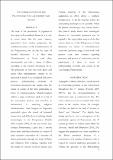Files in this item
The Christianisation of the Peloponnese : the case for strategic change
Item metadata
| dc.contributor.author | Sweetman, Rebecca Jane | |
| dc.date.accessioned | 2015-05-15T15:31:06Z | |
| dc.date.available | 2015-05-15T15:31:06Z | |
| dc.date.issued | 2015-11 | |
| dc.identifier | 158001057 | |
| dc.identifier | 63af371e-6b90-4225-8cbb-a3f1545c1f7a | |
| dc.identifier | 84949532729 | |
| dc.identifier | 000365738400011 | |
| dc.identifier.citation | Sweetman , R J 2015 , ' The Christianisation of the Peloponnese : the case for strategic change ' , Annual of the British School at Athens , vol. 110 , pp. 285-319 . https://doi.org/10.1017/S0068245414000227 | en |
| dc.identifier.issn | 0068-2454 | |
| dc.identifier.other | ORCID: /0000-0003-2012-1021/work/60195842 | |
| dc.identifier.uri | https://hdl.handle.net/10023/6648 | |
| dc.description.abstract | The issue of the persistence of paganism is now quite well considered; however, it is only in recent times that the same concern approached from another perspective, the multifaceted nature of the Christianisation of the Peloponnese, has become the topic of detailed discussion. It is likely that Christianisation in Achaea took place incrementally and with a variety of effects according to the location. The processes of how this took place and under what circumstances remain to be discussed in detail. As a considered and active process, understanding methods of conversion should provide insights into the nature of society at the time, particularly in terms of communications. Church location reflects a range of choices made in terms of the conversion process and therefore is fundamental to analysing religious transformation. Such insights are important, particularly given the dearth of historical sources for, and difficulties of refining, church chronologies in the Peloponnese. In the case of the Late Antique Peloponnese, a great deal is known about many individual churches as a result of quite extensive excavation of a majority of them, particularly through the work of Pallas and Orlandos. This evidence, together with the results of a survey of all the known Late Antique churches in the Peloponnese undertaken in 2012, makes possible a synthetic interpretation of all the material within the surrounding landscape. While the precise chronologies may remain elusive, this present study shows how sociological theories of conversion processes can be applied to the topographic analysis of the Late Antique churches of the Peloponnese to help determine the nature of Christianisation across the diachronic range. In this work I will present some new theories regarding processes and phases of conversion, and the implications of these in terms of understanding networks and society in the Late Antique Peloponnese. | |
| dc.format.extent | 429203 | |
| dc.format.extent | 5034121 | |
| dc.language.iso | eng | |
| dc.relation.ispartof | Annual of the British School at Athens | en |
| dc.subject | D051 Ancient History | en |
| dc.subject | T-NDAS | en |
| dc.subject | BDC | en |
| dc.subject.lcc | D051 | en |
| dc.title | The Christianisation of the Peloponnese : the case for strategic change | en |
| dc.type | Journal article | en |
| dc.contributor.sponsor | The Royal Society of Edinburgh | en |
| dc.contributor.sponsor | The Royal Society of Edinburgh | en |
| dc.contributor.sponsor | Arts and Humanities Research Council | en |
| dc.contributor.institution | University of St Andrews. School of Classics | en |
| dc.contributor.institution | University of St Andrews. Centre for Ancient Environmental Studies | en |
| dc.contributor.institution | University of St Andrews. Office of the Principal | en |
| dc.contributor.institution | University of St Andrews. St Andrews Institute of Medieval Studies | en |
| dc.identifier.doi | https://doi.org/10.1017/S0068245414000227 | |
| dc.description.status | Peer reviewed | en |
| dc.identifier.url | http://arts.st-andrews.ac.uk/greekbasilicas/article/ | en |
| dc.identifier.grantnumber | n/a | en |
| dc.identifier.grantnumber | N/A | en |
| dc.identifier.grantnumber | AH/I022635/1 | en |
This item appears in the following Collection(s)
Items in the St Andrews Research Repository are protected by copyright, with all rights reserved, unless otherwise indicated.


